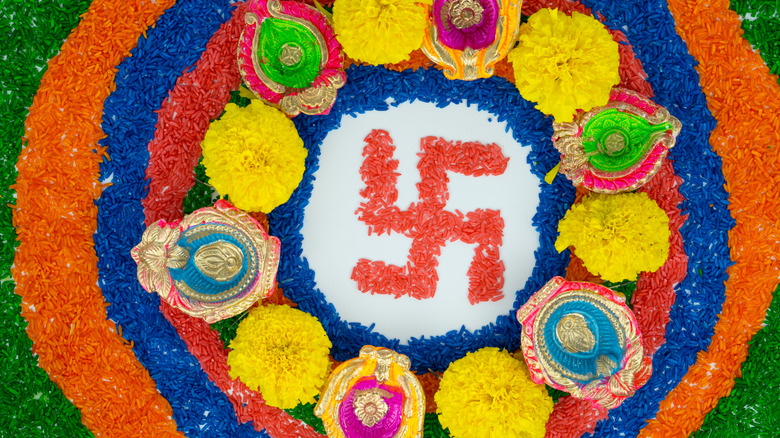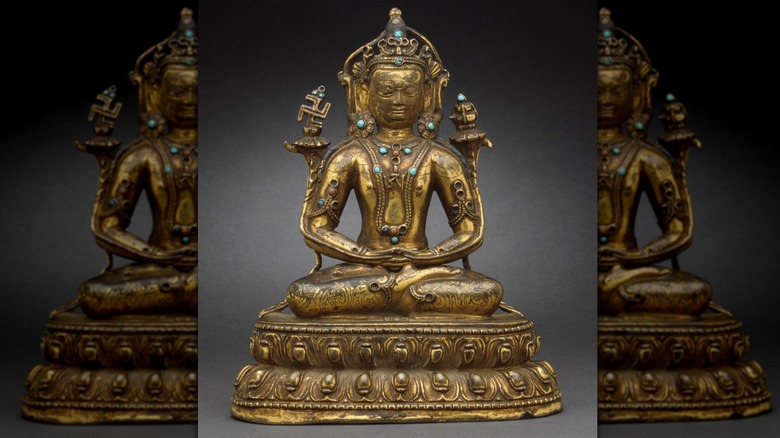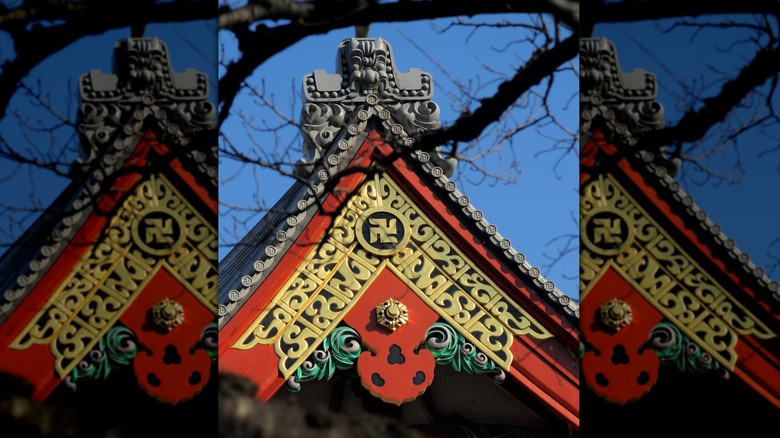The Original Meaning Behind The Swastika Isn't What You Think
On the very long list of crimes and atrocities the Nazis committed, spoiling a well-known icon ranks relatively low. Yet the fact that a symbol as widely spread and benign as the swastika is now almost wholly associated with evil speaks to the pervasive and lingering nature of Nazism. It's inconceivable that the swastika will be looked at as anything other than their emblem in the lifetime of anyone reading this, at least in the Western world.
It's an association that works against thousands of years of history. Joseph Campbell traced the earliest use of the swastika back to paleolithic times, on a carved ivory bird found near Kiev (per "The Flight of the Wild Gander"). Other early examples were also connected with birds, and it's been proposed that the swastika was originally a stylized depiction of a stork. Another theory suggests that it represented the movement of the sun in the sky. The word "swastika" comes from the Sanskrit word "svastika," and according to "The Encyclopedia of Asian-American Folklore and Folklife" by Jonathan Lee and Kathleen Nadeau, it means "all is well."
It may not have had any firm symbolism as it spread across early cultures. Swastikas have been found as decorative patterns on Egyptian textiles, as symbols on Mesopotamian coins, and in pottery designs from Iraq to Oklahoma (per Campbell). Christians used it on churches and monuments, the Scandinavians tied it to Thor's hammer, and the Navajo people saw it as a sacred, healing image.
The swastika became a sacred symbol in the East
Per the Association for Asian Studies, it isn't clear whether the swastika spread throughout ancient cultures from a common starting point or was developed independently, and it's a question unlikely to be answered. It does seem that, over time, the accepted meaning of the swastika broadly became one of good fortune (per Britannica). That association deepened in South Asia.
The swastika has been ubiquitous in the religious traditions of India for millennia. Per the Hindu American Foundation, it has multiple applications in Hinduism. The limbs of the swastika have been used to represent the seasons, the cardinal directions, and the four Vedas (or core scriptures). Many Hindu household doors are adorned with swastikas, reapplied every Diwali. In Jainism, the swastika represents the seventh tirthankara — a spiritual mentor — and the four possible destinations of a soul after reincarnation. And in Buddhism, the swastika represents the heart and footprints of the Buddha.
The swastika was one of several symbols that traveled with Buddhism from India into China and Japan by way of Tibet. The Association for Asian Studies says that it may be the only character in the Chinese writing system with a clearly foreign origin. The nobility of Japan took a particular shine to the swastika after its arrival in the 6th century. There, besides its continued religious use, it was a popular decoration in everything from pottery to heraldry.
Contact with Asian culture re-popularized the swastika in the West
The swastika retained a presence in the Old World outside of South and East Asia. Per the BBC, the Russians and other Eastern European peoples liked to use it in embroidery, to name just one example. But it was when Western societies came into renewed contact with the East that it gained new popularity in Europe and the United States. Inspired by its benevolent associations elsewhere, Westerners embraced it as a general sign of good luck. Others used it as a way to connect with India. According to the BBC, Rudyard Kipling was fond of it as a motif on his book covers for that reason, and the ties to India may have inspired the British Scouts to adopt it.
There was renewed academic interest in the origins and meaning behind the swastika. Thomas Wilson of the U.S. National Museum devoted an entire 1984 book — "The Swastika: The Earliest Known Symbol, and Its Migrations" — to the question of where the swastika came from and how it traveled through cultures (via Project Gutenberg). On the other end of human endeavor, marketers latched onto the swastika as a way to sell things. It branded fruit, playing cards, and novelty pendants that promoted Coca-Cola.
[Featured image by Fresh On The Net via Wikimedia Commons | Cropped and scaled | CC BY 2.0 DEED]
The Nazis used old research to tie the swastika into their ideology
German interest in the swastika has been connected with the discovery of Troy in 1871. Per the Smithsonian, Heinrich Schliemann, the German businessman who spearheaded the dig, found swastikas all over his find. They were so ubiquitous that Thomas Wilson felt compelled to discuss their Trojan presence in his book "The Swastika."
Wilson quoted linguist Archibald Sayce as saying that the swastika was a sign of the early days of the "Aryan race," and it was in the late 1800s that "Aryan" evolved from a description of a linguistic group to a notion of a pureblooded "master race" descended from antiquity. According to History Extra, Schliemann's colleague, Emile-Louis Burnouf, was prompted by the swastika's presence at Troy to study Hindu texts and forge a connection between them, the swastika, and the Aryans. Other scholars noted the similarities between Sanskrit and German, which fueled nationalist notions of Germany as the descendants of the Aryans.
For the swastika to represent this mentality meant ignoring its worldwide presence and traditional associations, but that didn't matter to the people and organizations that co-opted it. According to the Holocaust Encyclopedia, it became a popular symbol with far-right groups after World War I. The Nazis adopted it in 1920, with Adolf Hitler personally taking credit for red, white, and black design.
Can the original meaning of the swastika be restored?
After World War II, the Nazi swastika was banned in Germany, a ban still on the books there and in other European nations according to NBC News. While exceptions are made for swastikas used for religious purposes, the association with Nazism is so overwhelming in the West that, even where the symbol isn't outlawed, it is associated with nothing else and fiercely protested and resisted. In India and East Asia, however, the religious and cultural associations with the swastika endured World War II. And as the Asian diaspora grows in the West, tensions over the swastika have begun to rise.
Organizations like Hindus for Human Rights have protested blanket bans on public displays of the swastika, and individuals like the Buddhist priest T.K. Nakagaki have worked to reclaim its positive associations. But those involved in such campaigns have acknowledged the lingering pain that the Nazi swastika generates in the West. And some, including Shelley Rood Wernick of the Jewish Federations of North America's Center on Holocaust Survivor Care, have argued that the trauma of the Holocaust is such that whatever its meaning in other times and places, the swastika is beyond redemption as a symbol (via AP).




